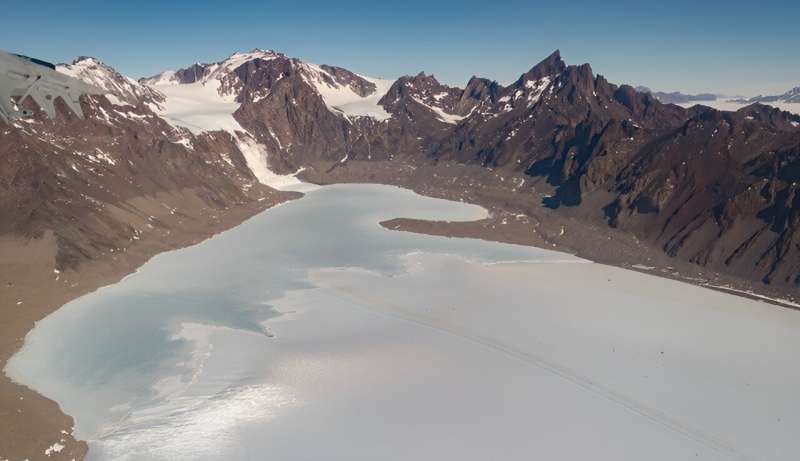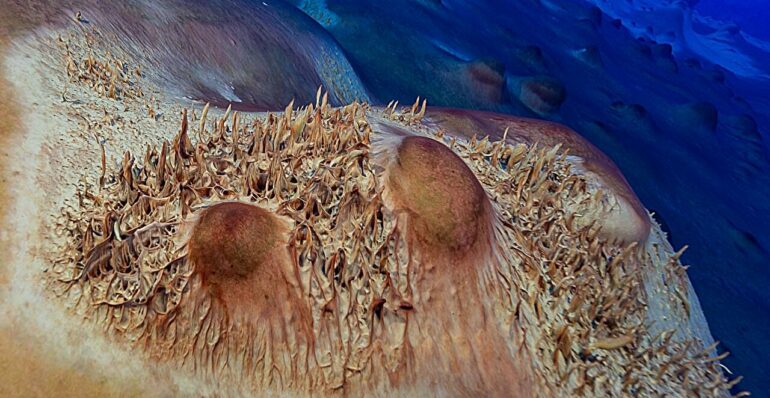In the depths of remote Antarctic lakes, communities of microorganisms are thriving where few life forms can survive. Scientists are studying structures formed by these communities to understand more about microscopic life in these extreme environments, which can offer clues about how life evolved.
Lake Untersee is the largest freshwater lake in the interior of East Antarctica.
With a surface constantly buried beneath several meters of ice and limited exposure to sunlight for much of the year, the lake is void of larger organisms like plants and animals. But in its depths, a rich ecosystem is helping scientists to understand more about how life evolved on our early planet.
Vast communities of microscopic organisms form peculiar structures on the bottom of the lake, from those shaped like small narrow pinnacles to larger cone-shaped structures. Why they form in two different shapes has been a mystery to scientists, but a recent study published in Environmental Microbiology seeks to answer this question.
Dr. Anne Jungblut, a microbial researcher at the Museum and an author of the study, says, “Because Lake Untersee has these two different formations, it allows us to study how these microbial structures formed.”
“If the microbes in these structures are similar, it would suggest they are primarily being shaped by environmental forces. But if they have a different species composition, it could mean that how these species grow has a bigger influence on the shape of these structures.”
“As these two structures are growing next to each other in the same environment, we think the species of microbes are playing a bigger role in influencing the structure’s shape. So, in this study, we wanted to take a closer look at the organisms that make up these structures.”

Lake Untersee is a large freshwater lake in eastern Antarctica, which is permanently covered in ice. © Dale T. Andersen and James Grecian
What are these structures made up of?
Although Lake Untersee is constantly covered in ice, just enough light penetrates to the depths of the lake, enabling photosynthetic life to survive.
The top layer of these microbial structures is very colorful, as it is full of photosynthetic organisms that make pigments to help capture the little light that reaches the lake floor. Below this layer, it looks like empty clay, but it is also full of different organisms that don’t use light for growth.
Researchers analyzed several tiny samples, each weighing less than one gram to learn more about the species that make up these different structures. They then extracted the DNA and used it to assemble the genomes of the different species to see what was present.
The samples contained a variety of single-celled organisms, such as Archaea, and more complex protists, such as microfungi, ciliates, and amoebas. The outside layers were largely made up of cyanobacteria, a type of photosynthetic bacteria that naturally occur in most freshwater ecosystems worldwide.
The two types of microbial structures were dominated by two different kinds of cyanobacteria. The cone-shaped structures contained a higher number of the thicker cyanobacteria Microcoleus, and the pinnacle-shaped structures contained a higher number of the thinner Elainellacea.
“Based on our research, we believe that cyanobacteria play a role in how these structures form,” says Anne. “So there must be some way they grow that leads to these different shapes.”
“But we don’t yet know why there are certain areas of the lake where different species grow and how these different microorganisms are interacting with each other. This is something we want to explore in our future research.”
How do these microbial structures tell us more about early life on Earth?
Each year, the microbial structures in Lake Untersee continue to grow as the combination of microorganisms and fallen sediment creates layers which can form large structures over hundreds of years and maybe even thousands of years.
These soft microbial structures form in a similar way to stromatolites, which first appeared on our planet billions of years ago and are among the oldest known fossils.
Although stromatolites are still around today, they are best known as a primary feature of the Archean, which stretched from 4 to 2.5 billion years ago. During this time, there were none of the plants, animals, or other complex organisms we see today.
The only life that existed was single-celled. Many stromatolites from the Archean were also made up of photosynthesizing cyanobacteria, and they are thought to be largely responsible for the oxygen-rich atmosphere that we depend on today.
Scientists are using the opportunity to study living microbial laminated structures to try and learn more about how life evolved during this early time in Earth’s history.
“Most habitats on Earth today have a lot of organisms that didn’t exist on early Earth,” says Anne. “So we study these structures in Antarctica because it is an extreme environment where not much can live and so better reflects what it would have been like during the Archean.”
“Lake Untersee is unique because it has these different shapes of microbial structures. Studying these structures can help us to learn more about how life evolved, formed and organized itself and how much it was influenced by environmental forces.”
More information:
Carla Greco et al, Genome‐resolved metagenomics reveals diverse taxa and metabolic complexity in Antarctic lake microbial structures, Environmental Microbiology (2024). DOI: 10.1111/1462-2920.16663
Provided by
Natural History Museum
This story is republished courtesy of Natural History Museum. Read the original story here.
Citation:
Microbial structures in Antarctic lake could reveal more about how life evolved (2024, July 17)



